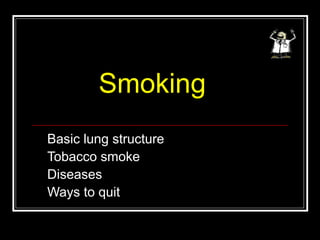Grade 11 - Gas Exchange and Smoking
- 1. Smoking Basic lung structure Tobacco smoke Diseases Ways to quit
- 3. Functions of lung components Trachea - takes air from nose and mouth down to bronchi Bronchi – Take air to smaller bronchioles Bronchioles – smaller tubes that branch more and more to take air to alveoli Alveoli – air sacs with thin walls made of single cells, allows diffusion of oxygen and carbon dioxide to happen quickly
- 4. Function of ciliated epithelium in trachea and bronchi Cilia move mucus and trapped dirt and bacteria out of tubes up towards throat Goblet cells make mucus which traps dirt and bacteria Mucus and cilia help to keep the airways clear of dirt and bacteria preventing infections
- 5. The Dangers of SmokingThe Dangers of Smoking What does smoking do to ourWhat does smoking do to our bodies?bodies?
- 6. Hydrogen cyanide Carbon monoxide Tar Nicotine Carcinogens Click through to see what’s inside a cigarette And something you’ll never get from a cigarette…
- 7. Cigarette smoke contains many toxic compounds
- 8. TAR This black sticky substance contains thousands of chemicals, some of which are cancer causing (carcinogenic)
- 9. Carbon monoxide The haemoglobin in your red blood cells will pick up carbon monoxide rather than oxygen. This reduces the amount of oxygen carried to the cells in your body. It certainly causes many problems - especially for a developing baby if the mother smokes.
- 10. Nicotine Nicotine is an addictive drug that acts directly on the brain. It is the reason smokers find it difficult to give up. It raises the heart rate and blood pressure which can lead to other health problems. It also make blood cells sticky and can lead to blood clots that can cause strokes and heart attacks
- 11. Hydrogen cyanide This is a poisonous gas that is often used to execute prisoners in the USA! And smokers breathe it in with every drag on a cigarette. It damages cells in the lungs.
- 12. Smoking related diseases Cancers caused by the carcinogens in cigarette smoke Emphysema- when the alveoli walls break down and gas exchange is reduced Bronchitis – inflammation and infections that occur when mucus accumulates because the cilia stop working
- 13. Lung cancer and tumour
- 14. Outside lung Inside lung tumour
- 15. Emphysema destruction of the air sacs (alveoli) for gas exchange leads to extreme shortage of breath on exercising
- 16. Bronchitis Inflammation of the bronchi – heavy coughing, thick mucus, difficulty breathing
- 17. Carbon monoxide Can cause babies to have a low birth weight if mother smokes during pregnancy Due to less oxygen reaching the growing foetus
- 18. Babies birth weights against number of cigarettes smoked
- 19. Methods to quit Hypnotherapy Acupuncture Nicotine patches Habit change Will power
- 20. What are you giving up if you carry on smoking? The opportunity to spend all that money on something else. Music, i-pod, i-phone, sports equipment Clothes Holidays Car Or anything else you might set your heart on!
- 21. Only five a day from age 14 to age 30 or Rp 124.100.000 Smoke 15 a day for 20 years or Rp 595.000.000 (but you probably won’t survive long enough anyway if you smoke that many!) Ten years smoking 25 a day or Rp 391.000.000,- 50 a day for 35 years or Rp 2.720.000.000 And something you’ll never get from smoking…
- 22. Effects of cigarette smoke components on the body substance Effect on the body Tar Accumulates in airways DOES NOT go into bloodstream Paralyses cilia Stimulates goblet cells to make more mucus Causes chronic bronchitis and emphysema Carcinogens Cause mutations to cells in bronchi walls leading to formation of tumours Carbon monoxide Absorbed into the blood stream Combines with haemoglobin to form carboxyhaemoglobin Reduces oxygen carried by the red blood cells nicotine Absorbed into the blood stream Increases heart rate Makes platelets more sticky, increases chance of clots forming Makes small arteries constrict
